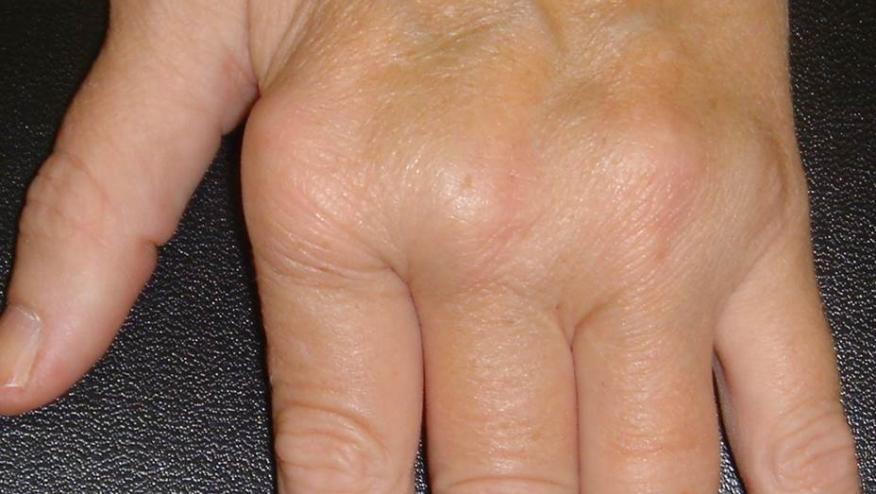Rheumatoid Progression Slowing Down Save

Patients with early rheumatoid arthritis (RA) with onset in the modern era had significantly lower baseline and annual rates of radiographic disease progression versus those with onset before 2001, researchers in England reported.
Among two cohorts of RA patients spanning 25 years, 74% of patients recruited from 1986 to 2001 progressed on average ≥5 units per year over 5 years of follow-up, compared with only 27% of patients recruited from 2002 to 2013, according to Lewis Carpenter, PhD, from the Centre for Clinical and Health Service Research at the University of Hertfordshire in Hatfield, and colleagues.
A change of at least 5 Sharp/van der Heijde (SvdH) units has traditionally been used to define a minimal clinically important difference. More intensive treatment may be responsible for the reduction in radiographic progression of disease, the authors wrote in Arthritis Care & Research.
In addition, although rheumatoid factor (RF) status is still a significant predictor of radiographic damage, it is no longer associated with clinically meaningful changes in radiographic damage, they said.
"Strikingly, the strong association of RF status and increased radiographic progression in the earlier time period was markedly diminished in the later time period. Those with RF-positive RA from 2002-2013 had markedly better radiographic outcomes at 5 years than those with RF-negative RA in 1986-2001."
The authors assessed 5-year progression of erosions and joint space narrowing, and their associations with RF status in two large, multicenter cohorts with early RA: the Early RA Study (ERAS) in which 1,662 patients were recruited from 1986 to 2001 and the Early RA Network (ERAN) that enrolled 1,216 patients from 2002 to 2013. Radiographic joint damage was recorded using the SvdH method in each study.
Maximum follow-up for ERAS was 25 years, with a median of 10 years, and for ERAN the maximum was 11 years with a median of 3 years. Patients were treated based on the standard clinical practice of the time. The 12-month cumulative use of disease-modifying antirheumatic drugs (DMARD) was 71.6% for the ERAS cohort and 95.3% for the ERAN cohort. Twelve-month cumulative sulfasalazine use was higher in ERAS compared with ERAN (55% versus 33.1%), while methotrexate use was substantially lower in ERAS versus ERAN (1.4% versus 52.1%).
Radiographic data were available for 1,216 patients from ERAS and 446 from ERAN. Patients from ERAN had a lower mean total SvdH score at baseline compared with ERAS (6.2 versus 10.5, P<0.001). The mean annual rate of progression was 65% slower in the later ERAN cohort (2.5 versus 6.9 per year, P<0.001). The estimated increase in damage was 1.5% per year for ERAS and 0.6% per year for ERAN patients. Some 74% of ERAS patients and 27% of ERAN patients progressed ≥5 SvDH units.
Each additional calendar year decreased the risk of radiographic progression by 3%, P<0.05).
The results were similar for joint space narrowing. Baseline scores were lower for ERAN participants compared with the ERAS cohort (3.6 versus 7.4, IRR 0.49, P<0.001), and the annual rate of progression over the first 5 years was also lower in the ERAN patients compared with ERAS patients (1.2 versus 3.9, IRR 0.31, P<0.001).
The erosion score at baseline was similar for both cohorts (P=0.593), however, the ERAN cohort exhibited a slower annual rate of progression over the first 5 years compared with ERAS (0.8 versus 1.9, IRR 0.43, P<0.001).
For the total SvdH score, RF-positive RA was not significantly associated with increased radiographic damage at baseline compared with RF-negative RA in either cohort. RF-positive RA, however, was associated with a 70% increased annual rate of progression, compared with RF-negative RA in ERAS (8.6 versus 5.1, P<0.001), which was statistically significant. The annual rate of progression for RF-positive RA compared with RF-negative RA in ERAN was increased by 9% (2.0 versus 1.9), which did not achieve statistical significance (P=0.855).
Two possible explanations for the findings are that RA may have become milder, and that earlier more intensive treatment may have improved disease outcomes, the authors wrote.
The first explanation is supported by the lower SvdH scores in ERAN compared with ERAS at baseline, prior to DMARD initiation.
"However, the reduction in radiographic progression is likely to also reflect improvements in the treatment of RA, given the earlier and increased use of methotrexate as the first line DMARD observed in ERAN in this study, which is in line with other reports," they wrote.
Study limitations included the lack of radiographs for all participants, with the possibility that patients with more severe disease were more likely to have imaging done.









If you are a health practitioner, you may Login/Register to comment.
Due to the nature of these comment forums, only health practitioners are allowed to comment at this time.